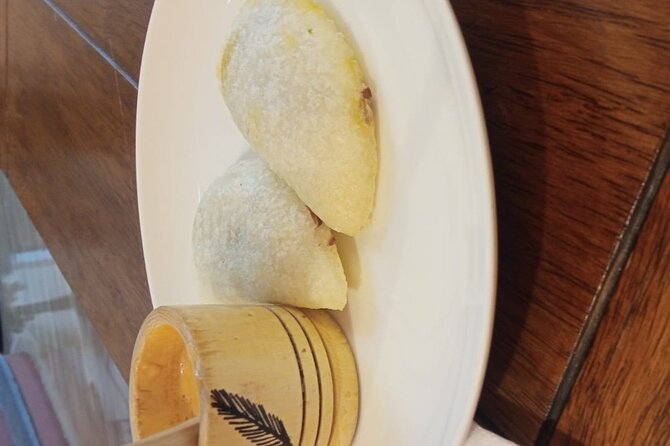Ecuador’s culinary landscape captivates with its rich diversity, reflecting a blend of indigenous traditions and regional ingredients. From the coastal ceviche, bursting with citrus flavors, to the comforting locro de papa from the Andes, each dish offers a glimpse into the country’s heritage. Street vendors serve up llapingachos and anticuchos, showcasing the vibrant life of local markets. As one explores the unique beverages like chicha, the question arises—what stories do these flavors tell about Ecuador’s past and present? The journey through these tastes reveals much more than just food.
Good To Know

- Ecuadorian cuisine features a vibrant blend of flavors from indigenous traditions, Spanish influences, and coastal seafood, creating unique culinary experiences.
- Popular dishes like ceviche, locro de papa, and hornado showcase the diverse ingredients and regional specialties found across the country.
- Street food delights, such as llapingachos and anticuchos, reflect the heart of Ecuadorian culture, offering authentic tastes and experiences.
- Traditional beverages like chicha and canelazo highlight the agricultural abundance and cultural heritage of Ecuador, enhancing the overall dining experience.
- Culinary tours and cooking classes provide immersive opportunities to explore Ecuador’s flavors, deepening appreciation for its rich gastronomy and traditions.
Traditional Ecuadorian Dishes

Ecuadorian cuisine bursts with vibrant flavors and rich traditions, showcasing a delightful array of dishes that reflect the country’s diverse cultural heritage.
From the iconic ceviche, a refreshing seafood dish marinated in citrus juices, to the hearty locro de papa, a creamy potato soup enriched with avocado and cheese, each plate tells a story.
The famous hornado, slow-roasted pork served with crispy skin, pairs perfectly with llapingachos, flavorful potato patties.
Street vendors tempt passersby with empanadas, stuffed with cheese or meat, while the sweet taste of fanesca, a traditional soup enjoyed during Easter, highlights the blend of ingredients unique to Ecuador.
This culinary landscape invites everyone to savor its authenticity and celebrate its cultural roots.
Find more activities and experiences we've covered in Quito.
Regional Specialties of Ecuador
Across the diverse landscapes of Ecuador, regional specialties emerge, each offering a unique taste of the local culture and traditions. From the coastal flavors to the highland dishes, Ecuador’s culinary diversity captivates foodies.
| Region | Specialty |
|---|---|
| Coastal | Ceviche de Choclo |
| Highlands | Hornado |
| Amazon | Patacones |
| Galapagos | Pulpo al Olivo |
Ceviche de Choclo showcases fresh corn and seafood, while Hornado features succulent roasted pork, reflecting highland heritage. In the Amazon, Patacones—fried plantain slices—delight with their crispy texture. Lastly, Pulpo al Olivo from the Galapagos combines local octopus with a zesty olive sauce, creating a memorable dining experience. Each dish tells a story of its region.
Street Food Delights

Street food in Ecuador bursts with vibrant flavors and enticing aromas, drawing locals and visitors alike to bustling markets and lively street corners. Vendors skillfully prepare an array of dishes that tantalize the taste buds.
From the savory llapingachos—golden potato patties stuffed with cheese—to the comforting humita, a corn-based treat wrapped in corn husks, each bite offers a taste of Ecuador’s culinary heritage.
Street carts serve up fresh ceviche, marinated seafood accompanied by crispy plantain chips, while skewers of grilled meat, known as anticuchos, are a must-try.
The infectious energy of the streets amplifies the experience, inviting everyone to indulge in these delicious delights that reflect the heart and soul of Ecuadorian culture.
Popular Ecuadorian Beverages
A variety of popular beverages in Ecuador showcase the country’s rich agricultural heritage and cultural traditions, capturing the essence of its vibrant landscapes and warm hospitality.
Among these, chicha stands out—this fermented corn drink has deep indigenous roots and varies by region.
Canelazo, a warm spiced drink made from sugar cane alcohol and fruit juice, warms chilly evenings in the Andes.
For a refreshing option, locals savor agua de panela, made from dissolved panela (unrefined cane sugar) mixed with water, often infused with lime or ginger.
Plus, fruit juices burst with flavors from the country’s diverse tropical fruits, like guanabana and maracuja.
Each sip tells a story, reflecting Ecuador’s unique blend of history, culture, and agricultural abundance.
Influences on Ecuadorian Cuisine
Ecuadorian cuisine is a vibrant tapestry woven from indigenous traditions, Spanish colonial influences, and the rich biodiversity of the country’s landscapes.
The indigenous peoples contributed staples like potatoes, corn, and quinoa, which form the backbone of many dishes. Spanish colonizers introduced new ingredients, such as rice, meats, and spices, creating a fusion that characterizes Ecuador’s culinary scene.
Coastal regions boast seafood dishes infused with African flavors, a testament to the diverse cultural heritage. Plus, the Andes contribute unique ingredients like highland grains and root vegetables.
Local markets brim with fresh produce, highlighting the country’s agricultural wealth. This blend of influences results in a culinary landscape that’s both varied and deeply rooted in Ecuador’s history and geography.
Culinary Tours in Ecuador
Culinary tours in Ecuador offer a delicious opportunity to explore the country’s diverse flavors, showcasing the rich cultural influences that have shaped its cuisine over centuries.
These tours immerse participants in local traditions, allowing them to savor authentic dishes while learning about the ingredients and techniques that define Ecuadorian gastronomy.
Here are three highlights of culinary tours in Ecuador:
Local Markets: Tourists visit vibrant markets, where they can taste exotic fruits and fresh produce, discovering the region’s agricultural bounty.
Cooking Classes: Guided by local chefs, participants learn to prepare traditional dishes, gaining hands-on experience.
Street Food Adventures: Travelers indulge in popular street snacks, experiencing the lively atmosphere of Ecuador’s culinary scene.
These experiences create lasting memories and deepen appreciation for Ecuador’s culinary heritage.
Sustainable Food Practices
Sustainable food practices in Ecuador reflect a harmonious blend of ancient agricultural techniques and modern environmental awareness, ensuring that local communities thrive while preserving their rich culinary heritage. Farmers often use crop rotation and organic fertilizers to maintain soil health, while community gardens promote biodiversity and food security. The connection between food and culture remains strong as families gather to share meals made from locally sourced ingredients.
| Practice | Description | Benefits |
|---|---|---|
| Crop Rotation | Alternating crops in fields | Enhances soil fertility |
| Organic Farming | Avoiding synthetic pesticides | Protects ecosystems |
| Community Gardens | Collective cultivation of crops | Fosters community engagement |
| Seasonal Eating | Consuming foods in their harvest season | Supports local farmers |
Unique Dining Experiences
Building on the rich traditions of sustainable food practices, unique dining experiences in Ecuador invite visitors to savor the vibrant flavors and cultural stories behind each dish. From bustling markets to intimate dining spots, the culinary landscape captivates all senses.
Traditional Cooking Classes: Visitors can enjoy local culture by learning to prepare classic dishes like ceviche or llapingachos alongside skilled chefs.
Rooftop Dining: Stunning views of the Andes complement gourmet meals, creating a memorable dining atmosphere.
Farm-to-Table Experiences: Guests can enjoy fresh, locally sourced ingredients, often harvested just hours before they hit the plate, enhancing the connection to Ecuador’s rich agricultural heritage.
These experiences not only please the palate but also deepen the understanding of Ecuador’s vibrant culinary culture.
Frequently Asked Questions
What Are the Best Places to Try Traditional Ecuadorian Dishes?
She explores local markets, bustling street vendors, and cozy family-owned restaurants, savoring traditional dishes. Each bite reveals Ecuador’s rich culinary heritage, showcasing vibrant flavors and unique ingredients that make dining an unforgettable experience.
Are There Vegetarian Options in Ecuadorian Cuisine?
In Ecuadorian cuisine, there’re plenty of vegetarian options. Dishes like llapingachos, a savory potato cake, and various fresh vegetable soups delight vegetarians, showcasing the country’s rich agricultural diversity and vibrant culinary traditions.
How Can I Find Culinary Tours in Quito?
To find culinary tours in Quito, he recommends searching online platforms, checking local travel agencies, or exploring social media groups. Travelers often share experiences, helping others discover unique and delicious culinary adventures in the city.
What Is the Cost of Dining Out in Ecuador?
Dining out in Ecuador typically ranges from $5 to $20 per meal, depending on the venue. Street food offers delicious options at lower prices, while upscale restaurants provide a more refined dining experience for a bit more.
Is It Safe to Eat Street Food in Ecuador?
When exploring Ecuador, street food’s often safe, as long as travelers choose popular vendors and observe cleanliness. Locals enjoy these dishes daily, showcasing their vibrant culture and flavors, making it an exciting culinary adventure.
The Sum Up
Ecuador’s culinary landscape is a vibrant celebration of flavors, reflecting its rich cultural heritage and diverse regions.
From the refreshing tang of coastal ceviche to the heartwarming embrace of highland soups, each dish invites exploration.
Street food pulses with life, while traditional beverages tell stories of ancient roots.
As travelers savor these unique tastes, they not only indulge in delicious meals but also connect with the soul of Ecuador, discovering the heart and history behind every bite.
More Tour Reviews in Quito
- 10 Days Birding Photo tour from Andes to Amazon of Ecuador
- 10 Days Birding Photo tour from Andes to Amazon of Ecuador
- Private Tour at Cotopaxi and Quilotoa One Day Include Paint Class
- Private Photo Session With a Local Photographer in Quito
- Private Cotopaxi Excursion in Tanicuchi Ecuador
- Roses & Horseback Riding (Private Day Trip From Quito)
Looking for something different? Other Quito activities we've written about
- 10 Days Birding Photo tour from Andes to Amazon of Ecuador
- 10 Days Birding Photo tour from Andes to Amazon of Ecuador
- Private Tour at Cotopaxi and Quilotoa One Day Include Paint Class
- 9 Best Guided Tours In Quito
- 25 Best Shopping Tours In Quito
- 11 Best Workshops And Classes In Quito
- 20 Best Spa And Hot Springs Experiences In Quito
- 20 Best Historical Tours In Quito
- 25 Best Tours In Quito
- 20 Best 3 Day Tours In Quito
- 19 Best 4 Day Tours In Quito
- 20 Best Private Driver Services In Quito
